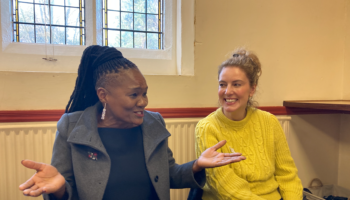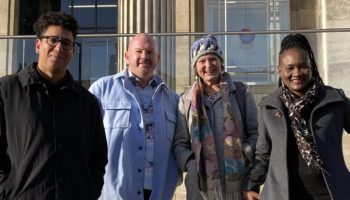Rosie Clare Shorter is a feminist researcher interested in gender, sexuality, religion and posthumanism. She is currently a PhD candidate in the Religion and Society Research Cluster at Western Sydney University, and a Teaching Assistant at the University of Melbourne.
‘And a woman was there who had been subject to bleeding for twelve years, but no one could heal her’ (Luke 8:43)
In February 2020, I was sitting in church as part of my PhD fieldwork.[1] Erica Hamence, Associate Minister at Barneys Broadway was preaching on Luke 8. In this passage, an unnamed woman seeks Jesus for healing. Due to a menstrual related illness, she would have been an outcast. Ilana Cohen explains that according to Leviticus, menstrual and uterine bleeding was a risk to the spiritual purity of the social body.
To help the congregation focus on what this woman’s story might teach them, Hamence did something that surprised me. She spoke about her own bleeding body.
Hamence told us how, after menstruating for the first time, on primary school camp, a (male) teacher embraced her and said, ‘I heard you became a woman yesterday.’
There is horrified laughter.
I write down, ‘I’ve never heard a woman openly talk about periods like this, in this setting.’
Why were periods in the pulpit such a surprise?
An obvious answer
I had never heard a preacher, a woman preacher, use periods as a lens for understanding the Bible, because growing up, I never heard a woman preach. The complementarian view that men and women are ‘equal but different,’ common in my Anglican diocese, meant women were not permitted to preach.
Sociologist Meredith McGuire (2008, p. 159) helps us think about how religion is gendered by asking, ‘If, in my religion, men’s rituals are completely separate from women’s do we all experience the same religion?’ In many ways, we don’t. Complementarianism creates unequal gendered pathways.
A growing body of social research shows us that religious teaching which creates gendered pathways based on the belief men and women are equal but different is a contributing factor in instances of gendered violence and a barrier to truly addressing gendered inequality. Kylie Maddox Pigeon (2016, 2021) argues that in complementarian churches, women are less likely than their male counterparts to access pastoral care, support or mentoring from a minister who is the same gender. Canadian evangelical author Sarah Bessey (2015, p. 41) recalls her discontent with gendered pathways in church, writing,
There are folks who believe that I – as a woman who hasn’t been to seminary – can’t possibly play with the big boys when it comes to theology. My opinions don’t matter as much; my experiences with Scripture and church, life and the Spirit don’t count.
Gendered expectations can discredit and limit those of us who are not men. Emma, an Anglican woman I interviewed, described the lack of women preaching in her previous churches as a ‘harm.’ She says, ‘I didn’t feel … that God would use me in a particularly significant way.’ Bleeding bodies and women preaching seem to be out of place in the theology of ‘the big boys,’ while gender diverse people rarely even get a look in.
Knowing about periods and sexism
We can learn from feeling out of place. Feminist theorist, Sara Ahmed (2021, p 137) says that ‘when spaces are intended for specific purposes, they have bodies in mind. Perhaps we can tell whom spaces are intended for when those for whom they were not intended turn up.’ When bleeding bodies ‘turn up’ in the pulpit we learn who the pulpit is ‘intended for’. Pulpits are considered men’s space, and preaching is a men’s activity. Sociologist Sarah-Jane Page (2014, p. 298) describes the church as ‘an occupational space where masculinist norms and traditions have been embedded for centuries’. Women may be suitable for creche and cooking, but bleeding bodies are unknown and unseen in the pulpit. Chris Bobel (2020) describes lack of knowledge about menstruation as a symptom of misogyny, suggesting ‘it is transgressive to resist norms of menstrual (and menopausal) concealment.’ This means as we come to know and speak about periods, we also know and speak about sexism.
Long before I knew about periods or sexism, Adrienne Rich (1986) posed the question, ‘what does a woman need to know to become a self-conscious, self-defining human being?’ Borrowing from Rich, I’m starting to ask, what does a Christian woman need to know so that she can grow and thrive in her faith? According to Rich, one thing women need is a knowledge of how their bodies have been used against them. So, one thing Christian women need to know is the way church communities and leaders have used our bodies, and our embodied experiences – like periods – against us.
Sarah-Jane Page and Heather Shipley (2020) remind us that bleeding bodies have long been a cause for exclusion. They trace how 19th century ideology of separate spheres (public sphere for men; private sphere for women) marked women as emotional, their bodies as weak, pure yet simultaneously sexual. This rendered women unsuitable for public roles both secular and sacred.
While complementarianism does draw on biblical texts, it also maintains these secular, cultural norms of separate spheres. Women are deemed unsuitable because they have messy bodies that bleed and breastfeed and therefore supposedly belong in private, domestic spaces.
Disrupting sexism
Against this sexist history, a woman using her own experiences of bleeding as a lens through which to preach the Bible is a surprise. One way to disrupt sexism and gendered violence in the church is by refusing to conceal the realities of our bodies.
Knowing the ways in which our bodies have been used against us, yet still choosing to affirm our bodies and allow embodied experience to inform Bible reading and preaching, can help women and gender diverse people survive and flourish in the spaces where we have been made to feel out of place. I hope I always remember Emma saying that hearing women preach showed her ‘this truth is for me as well.’
Surprise! Our bodies, voices and experiences – including periods! – can belong here, in the church and in the pulpit.
References
Ahmed, S 2021, Complaint! Duke University Press, Durham and London.
Bessey, S 2015, Out of Sorts: Making peace with an evolving faith, Darton, Longman and Todd, London
Maddox Pidgeon, K 2021, ‘Complementarianism and Domestic Abuse: A Social Science Perspective on Whether “Equal but Different” Is Really Equal at All,’ in RW Pierce & C Long Westfall (eds.), Discovering Biblical Equality: Biblical, Theological, Cultural, and Practical Perspectives. (Third Edition), Inter-varsity Press, pp. 551-578.
McGuire, MB. 2008, Lived Religion: Faith and practice in everyday life, Oxford University Press, Oxford.
Page, SJ 2014, ‘The Scrutinized Priest: Women in the Church of England negotiating professional and sacred clothing regimes’, Gender, Work and Organisation, vol. 21, no. 4, doi: 10.1111/gwao.12035
Page, SJ & Shipley, H 2020, Religion and Sexualities: Theories, themes and methodologies, Routledge, London and New York.
Rich, A 1986, ‘What Does a Woman Need to Know (1979)’,in Blood, Bread and Poetry (Selected Prose), W.W Norton and Company, New York and London, pp. 1-10.
*Feature image “Menstruation” by areta ekarafi, licensed under CC BY-NC-ND 2.0.
[1] While all parishioners and most ministry staff who were interviewed or surveyed for my PhD were given pseudonyms, some staff, including Hamence, chose to be named.






